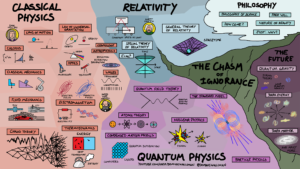Today’s post is somewhat different than usual. I’m highlighting a YouTube channel.
Communicating science to a general audience has a long history. The bibliography for my physics blog contains some books by authors to this purpose. Modern physics has many great stories, and the just plain strangeness of quantum physics lends itself to great storytelling. I’m particularly interested in efforts using visualization (which includes dramatization) to communicate what physics says.
The Online Video section of my physics blog contains examples of lectures and visualizations. Most of these presentations are by well-published “rock stars” or scientists at universities and research facilities.
And then there are small teams or “lone rangers” with a passion for explaining what physics says, whether they have any formal title such as visualization scientist or science communicator.
Which gets me to Dominic Walliman’s Domain of Science YouTube channel. I discovered this channel today due to a Sciencealert.com article “This Genius Map Explains How Everything in Physics Fits Together” (August 9, 2018).
To straighten that out once and for all, YouTuber Dominic Walliman has created a map that shows how the many branches of physics link together, from the earliest days of classical physics and Isaac Newton, all the way through to Einstein’s relativity and quantum physics (with a little bit of philosophy thrown in there for good measure).
[The Map of Physics YouTube video published on Nov 27, 2016]
Here’s Walliman’s description for his channel:
Hey welcome to the Domain of Science. I’m Dominic Walliman and I make these videos. I love science, and really like finding ways of explaining it to others because learning something new is the best, and science has a lot of mind-blowing stuff in it.
I have done a lot of quantum physics in the past, I did a PhD in quantum device physics and worked at a quantum computer company called D-Wave. As well as making these videos I write children’s books about science with Professor Astro Cat. http://www.google.com/search?q=professor+astro+cat
His other YouTube videos include:
- 5 Quantum Computing Misconceptions
- Quantum Supremacy Explained
- 5 ways you use quantum technology every day
- Your Quantum Nose: How Smell Works
- The Map of Mathematics
- Gravitational Waves Are Awesome
- Quantum Computing

Additional Domain of Science videos
• “Behind The Scenes at CERN the Largest Particle Accelerator in the World” (published Sep 6, 2019)
“One cool thing about being a mildly successful youtuber is that occasionally I get an invite to a cool place, and earlier this year I got an invite to go visit CERN … so I booked a quick flight over to Geneva and got to visit on the day I went, and saw one of the detectors. I saw the control center, the data center, and also the magnet factory. So let me show you what I saw. It’s CERN! There’s lots of names for lots of different things.
“I’ll start with the bird’s eye view just to orient you. CERN is a campus of buildings and load of tunnels underground on the border of Switzerland and France. There are many different loops for accelerating particles but the most famous and biggest is the Large Hadron Collider – the LHC – which is a large ring with two proton beams circulating inside in opposite directions.
” I felt really fortunate to have gotten a chance to see the detector up close for myself, and the thing that impressed me was not only the sheer size of it (and it was huge) but also the density of everything. You know there’s loads of big things in the world like buildings, but not many building-sized things that are made of solid technology. There were electronics detection panels, pipes, wires, giant magnets, and all of that stuff has to work together flawlessly.”
• “How to See Supermassive Black Holes Collide : The LISA Mission” (published Oct 3, 2019)

Using just some hand drawn diagrams, here’s another [Patreon] science communicator reminding us of what grounds some of our most successful theories – “assumptions, also known as axioms or postulates.”
• YouTube > Parth G > “Nobody Knows Why Wave Functions Exist – So We Just Assume They Do (Quantum Mechanics Postulates)” (November 2, 2021)